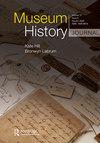Curators as keepers and exhibition makers: The British Museum’s African Galleries
IF 0.2
Q3 HISTORY
引用次数: 0
Abstract
ABSTRACT It is generally assumed that anthropological artefacts are fundamentally different from art works. This article questions aspects of this distinction by exploring the role of curators in anthropological collections, with a focus on the Africa Galleries at the British Museum. It looks at the complexities faced by the curators of a controversial collection, which is contested as ‘heritage’ and the curatorial practices used to address it in the late twentieth and early twenty-first century. It explores questions such as: can curatorial work narrate the Other outside power structures? How might it narrate other cultures? And can there be collaborations across cultures without collapsing into existing power structures? Johannes Fabian has argued that ethnography has two ‘moments’: the first involves close exchange and collaboration with other communities during field trips. The second involves the construction of an unchanging temporality through which another culture becomes Other and thus excluded from change. This exclusion applies a power relationship. The article demonstrates how the curators sought to develop exhibitions which critiqued the second moment and built on the first by collaborating with living artists. In so doing the curators also questioned the status of works in anthropological collections.策展人兼策展人:大英博物馆的非洲画廊
摘要人们普遍认为,人类学的人工制品与艺术作品有着根本的不同。本文通过探讨策展人在人类学藏品中的作用,对这种区别提出了质疑,重点是大英博物馆的非洲画廊。它着眼于一个有争议的藏品的策展人所面临的复杂性,这个藏品被称为“遗产”,以及20世纪末和21世纪初用于解决这个问题的策展实践。它探讨了一些问题,比如:策展工作能叙述其他外部权力结构吗?它可能如何叙述其他文化?在不瓦解为现有权力结构的情况下,是否可以进行跨文化的合作?Johannes Fabian认为民族志有两个“时刻”:第一个是在实地考察期间与其他社区的密切交流和合作。第二种是构建一种不变的时间性,通过这种时间性,另一种文化成为他者,从而被排除在变化之外。这种排除适用于权力关系。这篇文章展示了策展人如何通过与在世的艺术家合作,在批判第二个时刻并在第一个时刻的基础上发展展览。在这样做的过程中,策展人还质疑作品在人类学收藏中的地位。
本文章由计算机程序翻译,如有差异,请以英文原文为准。
求助全文
约1分钟内获得全文
求助全文

 求助内容:
求助内容: 应助结果提醒方式:
应助结果提醒方式:


